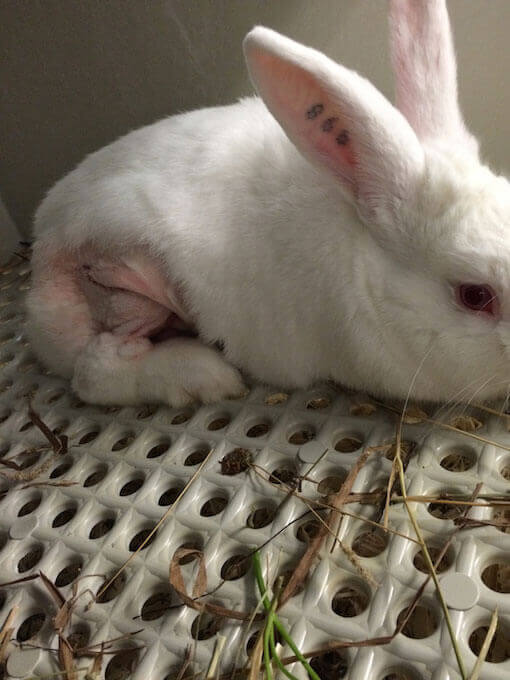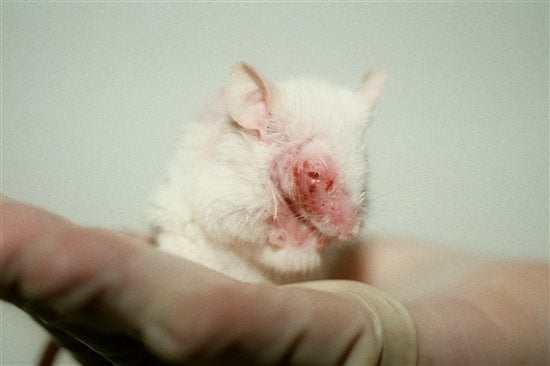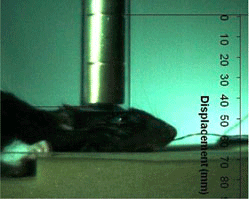How to Get Away With Murder: Do It in a Lab
If you were to poison your neighbor’s dog, burn your grandmother’s cat with a blowtorch, or drill into the skull of a rabbit, you’d likely face felony cruelty-to-animals charges. Unsurprising, right? What is dumbfounding, though, is the pass given to those who experiment on animals inside laboratories.
Below are six gruesome examples of things done to animals in labs that would land most people in legal hot water. But because this abuse is carried out by experimenters, the perpetrators don’t get jail time. Instead, they’re lauded by their peers and given lucrative grants to continue torturing animals. Take a look at these examples of abuse occurring in laboratories, and learn how you can help end this horrific injustice:
Poisoning Animals
A distraught whistleblower contacted PETA with shocking allegations of the abuse of animals in cruel and painful experiments at Shin Nippon Biomedical Laboratories (SNBL). SNBL force-fed experimental chemicals to animals in order to cause them to become ill and even die, and it infected them with debilitating diseases.
Electroshocking Animals
More than 100 million mice and rats are killed in U.S. laboratories every year. Many of them are deliberately electroshocked in pain studies. The Jackson Laboratory (JAX), for example, breeds, experiments on, and sells millions of mice every year. Some who are purchased from JAX by other facilities are repeatedly shocked. The company also subjects them to experiments in its own labs. Mice are highly sensitive, intelligent, and social animals who suffer greatly in experiments. Yet they’re denied any protection under the federal Animal Welfare Act (AWA).
Click here to urge NIH to stop funding cruel and abusive experiments on mice.
Breaking Animals’ Bones
Would you let a plastic surgeon perform crippling, painful orthopedic surgery on you? Two young rabbits named Jack and Daniels didn’t have a choice when an experimenter at a University of Pittsburgh (Pitt) laboratory came for them. The experimenter cut ligaments in their knees, then contorted their legs into an unnatural position and inserted wires into the knees to hold the legs in place. The purpose? To cause intentional trauma to the knee joints. After more than two weeks in this excruciating position, both rabbits had lost significant weight, indicating chronic pain and distress. But Jack and Daniels were forced to endure six more weeks of this agony.

Burning Animals Alive
Thanks to a whistleblower, we know that animals at the University of Texas Medical Branch–Galveston (UTMB) are being used in cruel experiments in which their bodies are burned, among other atrocities. According to the whistleblower, experimenters subjected sheep, pigs, and mice to third-degree burns over up to 40 percent of their bodies and forced them to inhale smoke from burning cotton. These cruel burn experiments are ongoing, and Shriners International has funded them extensively for decades. Just last month, a study co-authored by David Herndon—a UTMB experimenter—was published. It details how experimenters severely burned 60 percent of the surface area of rats’ bodies by dipping them into nearly boiling water.

Causing Animals Traumatic Brain Injuries
For years, the National Football League Foundation—formerly known as NFL Charities—has quietly funded horrific and deadly sports-injury experiments on dogs, mice, rats, and other animals. These projects are crudely designed to recreate injuries commonly sustained on the football field. They have involved repeatedly slamming heavy weights into rats’ heads to create brain and spinal cord injuries and skull fractures, cutting open the heads of mice and delivering crushing blows to the animals to cause traumatic brain injuries, and inflicting severe knee injuries on dogs, after which they’re killed and their legs are cut off.

These experiments don’t accurately replicate the complex injuries sustained by football players, and results derived from brain-injury experiments on animals have repeatedly failed to help human patients. Click here to urge NFL officials to stop funding cruel and wasteful experiments on animals.
Drilling Into Animals’ Skulls
An eyewitness investigation inside the laboratories of the University of Utah (the U) in Salt Lake City revealed that a hole was drilled into the skull of a cat named Robert and electrodes were attached to his brain.

After breaking the news of our shocking investigation, PETA received confirmation from the U that Robert would be retired from the laboratory and adopted into a new home. While this was excellent news for him, other animals are still suffering in the school’s laboratories. PETA recently uncovered new documents that show that experimenters at the U continue to violate and show flagrant disregard for animal-welfare laws. For instance, experimenters in a laboratory there removed a portion of a monkey’s skull and inserted electrodes into his brain in a grueling 14-hour procedure, even though they were unable o insert an IV catheter into the animal to deliver necessary fluids. Less than 24 hours later, the monkey died.
Warnings are not enough—real action must be taken against these abusers. Click here to take action.
Don’t Let Experimenters Get Away With Murder
There’s no difference between the animals who live in our homes and those who suffer in laboratories—and there shouldn’t be any difference in the punishments imposed on those who violate these animals’ rights. Yet because of state anti-cruelty statutes—many of which include language that exempts abuse of animals in laboratories—there are. But you can oppose this injustice. Click the button below to urge the Food and Drug Administration (FDA) to accept superior, non-animal methods in place of archaic and unreliable animal tests:
Learn more about experiments on animals on The PETA Podcast:
Listen to more episodes on iTunes and Spotify! Subscribe for new episodes.

